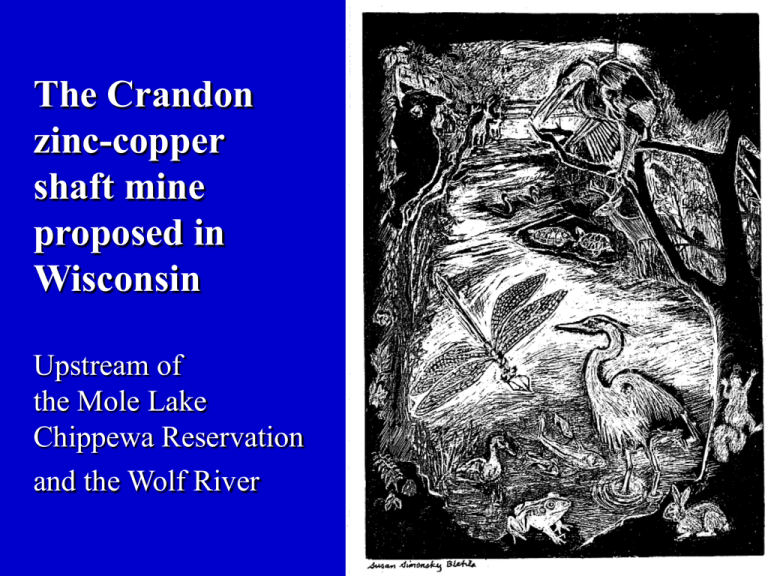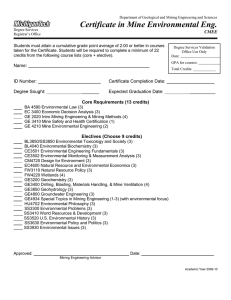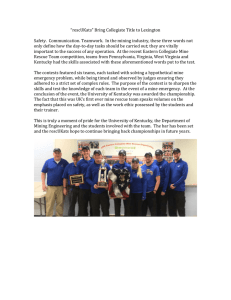The Crandon zinc-copper shaft mine proposed in
advertisement

The Crandon zinc-copper shaft mine proposed in Wisconsin Upstream of the Mole Lake Chippewa Reservation and the Wolf River Exxon’s first round (1976-86) 1976 Discovers one of North America’s largest zinc/copper sulfide ore bodies • 1981 Lobbyist James Klauser says WI “could host up to 10 metal mines by 2000...." • 1983Mines exempted from clean groundwater standards, toxic waste standard, foreign land ownership law. • 1986 Withdraws its permit application after Final EIS. • 1987 Klauser appointed Secretary of Administration in Tommy Thompson’s cabinet. • 1988 WI declares Wolf River "Outstanding Resource Water" Metallic mining concerns • Environmental – Sulfides (sulfuric acid) contaminate for 200,000 years – Heavy metals, cyanide, arsenic, etc. – 10,000 miles of U.S. rivers poisoned • Economic – Boom-and-bust effect – Impact on existing industries • Cultural – Native cultures – Rural lifestyle Environmental concerns • Run-off of sulfuric acid, heavy metals – impacts on fish, wild rice, other aquatic life • Drawdown of groundwater table from shaft pumping – Impacts on water supplies, wild rice, wetlands • Pumping groundwater – Treatment of contaminated water in perpetuity – Wastes monitored for 40 years 44 million tons of waste Tailings Management Area – 90 feet deep – largest toxic dump in WI history: 282 football fields • Waste rock backfill of shaft • Release of toxic dust into air Wetlands & springs in 4,800-acre mine site “You couldn’t find a more difficult place to mine.” -Exxon engineer Company’s environmental arguments • “Only old mines pollute” – Western U.S. acid mine drainage • “New technologies” – Wastewater treatment – Extraction of sulfuric acid from wastes • Isolate mine through “grouting” Economic concerns Effects on Wolf River tourism • Lack of jobs for locals – alternative economic options not explored • Boom-and-bust cycle – poorest areas often were mine-dependent • Sudden lay-offs or mine closure – swings in metal prices, reduced demands Company’s economic arguments • 400 jobs for mine operation – Keep kids in depressed rural area • Secondary contracts to area businesses – Crandon, Rhinelander, Antigo benefit • Mining equipment contracts – Milwaukee-area manufacturers Need for metals? • Low prices – Glut of zinc and copper – New sources in Russia, China • Less use – Plastics/ceramics in autos, piping – Fiber optics replacing copper wire • More metallic recycling Cultural concerns • Wild rice beds • Future of hunting/ fishing/gathering • Burials and sacred sites • Influx of outsiders • Rural social fabric Ojibwe (Chippewa) lands ceded in treaties Six Wisconsin reservations Treaties guarantee tribal access to resources Treaties & the environment • Federal courts recognize rights – Rights in ceded territories retained, not granted – Boldt 1974 WA, Voigt 1983 WI, Mille Lacs 1999 MN – Not just allocaiton, but habitat • Legal tool to guarantee access to resources – Not mineral rights, but prevent harm to resources • Basis of resource co-management with non-Indian govt’s Sovereignty & the environment • Federal trust responsibility to protect reservation – “EPA Treatment-As-State” in Clean Air Act, Clean Water Act • International legal tools – United Nations, international agreements “We have more in common with the anti-Indian people than we do with the State of Wisconsin.” — Spearfisher Walt Bresette, 1990 Exxon returns (1992-98) • 1992 Exxon returns to Crandon • 1995 CMC plan to pipe to reapply for mine permit (with wastewater to Wisconsin River Phelps-Dodge briefly). heightens opposition. • 1993 Exxon and Canada’s Rio • 1996 Wolf & Wisconsin R. Algom form Crandon Mining speaking tour draws 2000. Company (CMC). Lynne mine plan dropped by Noranda in Oneida County. Flambeau mine • 1997 Nashville voters oust pro-mine town board, elect new begins 4-year shipment of board to rescind “local copper ore from Ladysmith in agreement” with company. Rusk County. Niiwin (“Four”) Tribes • Mole Lake Chippewa – 1 mi. downstream – wild rice beds, water quality • Forest Co. Potawatomi – 5 mi. downwind – air quality, toxic dust • Menominee – 40 mi. downstream on Wolf R. • Mohican (Stockbridge-Munsee) Menominee Sustainable Forestry Chief Oshkosh Overcoming divisions • Race – Native Americans vs. white sportfishers • Class – Labor unionists vs. environmentalists • Region – Rural northern WI vs .urban southern WI Alliance to stop Crandon mine Native American nations –cultural concerns –wild rice, sacred sites Sportfishing clubs – fish, surface water, toxics Environmental groups – wetlands, groundwater, wildlife/species Growing alliance • Rural residents – economic impacts on tourism industry, northern lifestyle • Labor unions – environment, company health/safety track records • Students – corporate control, future sustainability • Farmers – feeder line to mine from Duluth-Wausau transmission line Proposed transmission lines From dams that flooded Cree land in Manitoba… …through MN/WI farmlands, partly to provide power for mine. Save Our Unique Lands (SOUL) http://www.wakeupwisconsin.com Fighting DuluthWausau 345-kilovolt transmission line, opposing 115-kv feeder line to Crandon Perrier/Nestle in Wisconsin Adams County farmers protect rural wells from high-capacity pumps; Ho-Chunk protect sacred sites, 2000-2002 Mecosta Co., Michigan Rio Algom goes it alone (1998-2000) • 1998 Exxon sells most • 1999 Mole Lake, Potawatomi Crandon mine interests to Rio win EPA backing for tribal laws Algom, which sets up Nicolet Minerals Company (NMC). • 1999 Federation of Fly Fishers rates the Wolf River as most • 1998 Mining Moratorium law endangered U.S. river. passed, undermined by DNR • 1999 NMC revises mine plans, sets back pipeline. • 2000 Speaking tour/rally against Crandon mine and DuluthWausau transmission line. Tribal and Federal Government • Tribal – Mole Lake “Treatment As State” (Clean Water Act) – Potawatomi “Treatment As State” (Clean Air Act) – Menominee, Potawatomi and Mole Lake technical research • Federal – Army Corps of Engineers wetlands permit; – Possible role of EPA – Federal lawsuits on DNR permit Local and State Government • Local – Nashville local agreement lawsuit; – Downstream gov’t resolutions • State – DNR permit process (2004 ?) – Mining reform bills Wisconsin mining reform bills • Mining moratorium (passed 1998) – Requires companies to show “safe” mines – DNR assessing 3 examples in AZ, CA, Canada • Cyanide ban (Passed Senate 2001; reintroduced 2003) – Mine would use up to 200 tons a year – Spills around world killed fish • No Special Treatment (passed Senate 2001; reintroduce 2003) – End legal exemptions for mining wastes Typical environmental movements • Stereotype of environmentalists – – – – Urban-based White Upper middle class “Not In My Back Yard” • Portrayal by companies – Hippies – Yuppie elitists – Don’t care about rural jobs Wisconsin movement • Unlikely Alliances 1994 – – – – – Rural-based Multiracial Middle/ working class Multigenerational “Not In Anyone’s Back Yard” • Dilemma for companies 2000 – Grassroots, common folk – Cannot easily be defeated Drawing from strands of Wisconsin history • Progressive populism – LaFollettes • Regional pride – Northern Wisconsin vs. “Madison” • Environmental ethics – Muir, Leopold • Native American rights – Opposed removal, treaty violations, termination BHP Billiton in control (2000-2003) • June 2002 BHP Billiton signals • 2000 Rio Algom and its NMC willingness to sell site to public. purchased by London-based South Alliance for joint management African miner Billiton. • Sept. 2002 NMC staff laid off • 2001 Billiton merges with but permit process continues. Australian mining giant Broken Hill Proprietary (BHP), forms BHP Doyle backs public acquisition. Billiton. • April 2003 Mine site sold to Northern Wisconsin Resource • Nov. 2001 Cyanide Ban and Group, owned by logging “No Special Treatment” bills pass company ex-owners of site. It WI Senate, held up in Assembly could find no corporate partner. CRANDON PROTESTS AUSTRALIA (BHP shareholders’ meeting, 2001) SOUTH AFRICA (at Sustainability Summit, 2002) Mining industry reaction to Wisconsin opposition “The increasingly sophisticated political maneuvering by environmental special interest groups has made permitting a mine in Wisconsin an impossibility.” —North American Mining (Toronto), 1998 “Wisconsin’s low investment attractiveness score suggests the impact of that state’s moratorium on mining, and a well-publicized aversion to mining. One vice president of exploration complains that in Wisconsin, you ‘can’t get anything done that is meaningful’.” —Fraser Institute Survey of Mining CEOs (Vancouver), 2000 Mining industry reaction The Vancouver-based Fraser Institute issues an annual Investment Attractiveness Index ranking the reception that all countries, states and provinces give the mining industry. Wisconsin ranked at the global bottom in 2003, with a score of 13 out of 100. More mining industry reaction Wisconsin anti-mining industry websites are operated by “barbarians at the gates of cyberspace.” —Mining Voice (Washington), 1998 “The Wolf Watershed Educational Project (WWEP), a U.S.-based alliance of environmental groups, Native American nations, local residents, unions and students ...is just one example of what is becoming a very real threat to the global mining industry: global environmental activism...” --Mining Environmental Management (London), 2000 The End: Oct. 28, 2003 Forest County Potawatomi and Mole Lake announce purchase of mine site for $16.5 million. The End: Oct. 28, 2003 Mole Lake takes ownership of Nicolet Minerals Company “We rocked the boat; Now we own the boat.” The End: Oct. 28, 2003 5,000-acre mine site will be managed to protect natural and cultural resources for future generations. The End: Oct. 28, 2003 Peace comes to Crandon area after 28 years of conflict. “Now the war is over.” The End: Oct. 28, 2003 Native/non-Native grassroots alliance wins a victory of of national and global relevance. Websites on Crandon mine No Crandon Mine links http://www.nocrandonmine.com Midwest Treaty Network http://www.treatyland.com Wolf River Protection Fund http://www.WolfRiverProtectionFund.org Books on Wisconsin mining Walleye Warriors (1999) by Walt Bresette And Rick Whaley New Resource Wars (1993) by Al Gedicks Resource Rebels (2001) by Al Gedicks Dr. Zoltán Grossman, Assistant Professor of Geography, University of Wisconsin-Eau Claire. Permission required for public use. grossmzc@uwec.edu (715) 836-4471 http://www.uwec.edu/grossmzc


